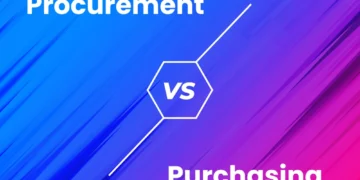Last Updated on November 28, 2025
Overview
When you own a business, you need a procurement plan. This plan will outline the steps that need to be taken to procure the necessary goods and services for your business. Having a procurement plan in place can avoid potential pitfalls and ensure that the process goes as smoothly as possible.
The goal of a procurement plan is to save time and money while procuring suitable goods or services for your business. It includes information on what needs to be procured, how it will be procured, and when it will be procured. Procurement plans can be short-term or long-term, depending on the length of the procurement project. The procurement process can be tricky, but it is crucial to have a procurement plan in place to ensure that everything goes well.
What Is Procurement Planning?
The procurement process involves determining what goods or services are required when they are needed, and in what quantities. The procurement plan outlines the business’s strategy for acquiring the necessary items and establishes a timetable.
Business engages in procurement planning to ensure they have the materials and resources needed to meet their goals and objectives. Effective procurement planning can help businesses to save time and money by avoiding last-minute purchases or emergency orders. Additionally, it can help companies to prevent stockouts or overstocking, which can disrupt operations.
There are a variety of factors that businesses must consider when engaging in procurement planning. These include understanding the organization’s needs, assessing supplier capabilities, and identifying potential risks.
Understanding a Procurement Plan
When creating or procuring anything, it is crucial to have a plan. The procurement process is no different—to get the best results, you need to have a clear and concise plan in place. Understanding what goes into a procurement plan makes it much easier to ensure everyone works towards the same goal.
The first step in creating a procurement plan is understanding your company’s needs. What are you looking to procure? What are your goals for this purchase? After considering your needs, you can begin to look at potential vendors and products.
Next, you will need to create a timeline for your procurement process. When do you need the product or service? What are your deadlines? By having a clear timeline, you can avoid any delays in the procurement process.
You can create a comprehensive and effective procurement plan by following these steps. And with a clear procurement plan in place, you can avoid any delays or problems in the procurement process.
Stages of Procurement Planning
There are main stages of procurement planning:
1. Defining the procurement requirements
The first stage of procurement planning is to define the requirements for the goods or services that are needed. This includes specifying the procurement’s quantity, quality, and delivery timeframes. The conditions must be clearly defined to ensure that suitable goods or services are procured.
2. Analyzing the procurement options
The second stage of procurement planning is to analyze the different options for procuring the goods or services. This includes considering cost, quality, delivery timeframes, and supplier reliability.
3. Developing the procurement plan
The third stage of procurement planning is to develop the procurement plan. This includes specifying the methods and processes used to procure the goods or services. The project should be designed to ensure that the procurement is carried out efficiently and effectively.
4. Implementing the procurement plan
The fourth stage of procurement planning is to implement the procurement plan. It is crucial to implement the plan and monitor its progress. The implementation of the project should be handled promptly when problems or issues arise.
5. Monetizing the procurement
The fifth is Monitoring the procurement process. It is essential to ensure that the procurement plan is followed and that procurement objectives are met. Evaluation of procurement performance is also important in order to identify any areas of improvement.
6. Evaluating procurement performance
The sixth stage is evaluating procurement performance. This is a critical part of the procurement stages. Businesses can identify areas where improvements can be made by assessing procurement performance. By doing so, companies can adjust their procurement process to improve their overall performance. Companies can use several procurement planning tools and techniques, including: – Make-or-buy analysis- Cost-benefit analysis- Supplier selection criteria- Supplier performance evaluations.
7. Continuous improving
The seventh and last is a continuous improvement. This is a vital part of procurement. By constantly improving the procurement process, businesses can ensure that they are always procuring the best possible goods and services for their needs. There are several ways to achieve continuous improvement in procurement, including Conducting procurement audits, Implementing procurement best practices, and Tracking procurement data.
Why Is Procurement Planning Important
Procurement planning is crucial because it helps businesses to save money and time when procurement the goods or services they need. By taking the time to plan for procurement, companies can avoid making rushed and costly decisions. Procurement planning also helps businesses to ensure that they procure suitable goods or services to meet their needs.
Procurement planning is a critical part of ensuring that procurement is carried out effectively and efficiently. It should be given due consideration to avoid procurement problems and delays.
What Are the Benefits of Procurement Planning?
There are several benefits of procurement planning, including:
- Ensuring that suitable goods or services are procured
- Minimizing procurement costs
- Reducing procurement lead times
- Improving supplier relationships
- Enhancing procurement efficiency.
By carefully planning the procurement process, businesses can realize these benefits and improve their overall procurement performance.
Conclusion
A well-thought procurement plan is a key to successful and stress-free buying. By taking the time to develop a plan that outlines your specific needs, you can avoid overspending or purchasing unnecessary items. Additionally, by researching different suppliers and considering your options, you can ensure that you get the best price for the products you need.
Frequently Asked Questions (FAQs):
What are the components of a procurement plan?
The component of the procurement plan includes:-
- The procurement requirements
- The procurement options
- The procurement timeline
- The procurement budget
- The procurement contract
How is the procurement plan done?
The procurement plan is done by first defining the procurement requirements. Once the requirements are known, the different procurement options should be considered. The best option should be selected based on the specific procurement requirements.
What are the seven stages of procurement?
The stages of procurement are:
- Defining the procurement requirements
- Analyzing procurement options
- Developing the procurement plan
- Implementing the procurement plan
- Monitoring the procurement process
- Evaluating procurement performance
- Continuous improvement.
What are the types of procurement plans?
There are two types of procurement plans: short-term procurement plans and long-term procurement plans. Short-term procurement plans are typically used for small projects with a lead time of less than one year. Long-term procurement plans are used for projects with more than one year of lead time.










Discussion about this post